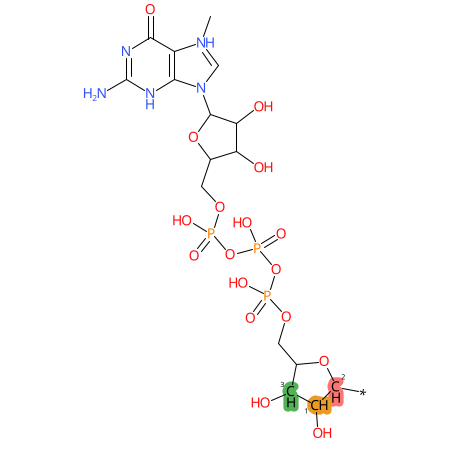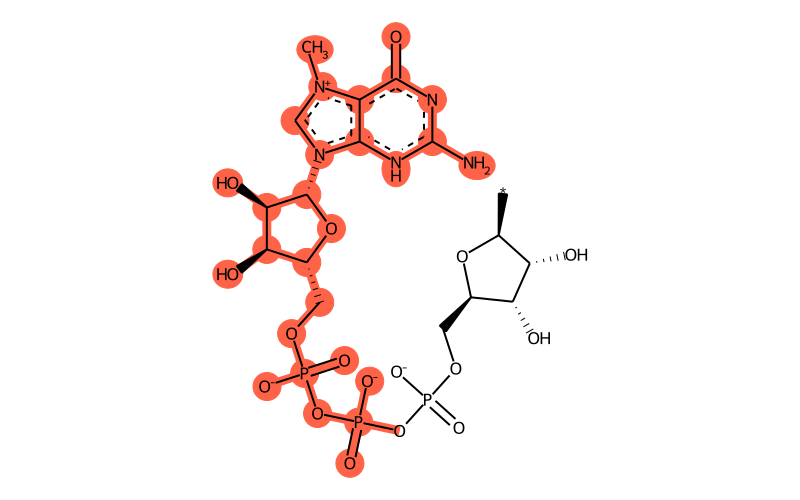Summary
| Full name | N7-methyl-guanosine cap (cap 0) |
| Short name | m7GpppN |
| MODOMICS code new | 2000079553N |
| MODOMICS code | 79553N |
| Nature of the modified residue | Natural |
| RNAMods code | © |
| Residue unique ID | 132 |
| Found in RNA | Yes |
| Enzymes |
Abd1 (Saccharomyces cerevisiae) Hcm1 (Homo sapiens) TRM112 (Homo sapiens) |
| Found in phylogeny | Eukaryota |
| Found naturally in RNA types | mRNA, snRNA |
Chemical information
| Sum formula | C16H23N5O17P3 |
| Type of moiety | nucleotide |
| Degeneracy | unspecified residue |
| SMILES | C[n+]1c[n]([C@@H]2O[C@H](COP([O-])(OP([O-])(OP([O-])(OC[C@H]3O[C@@H]%91[C@H](O)[C@@H]3O)=O)=O)=O)[C@@H](O)[C@H]2O)c2c1c(nc(N)[nH]2)=O.[*]%91 |
| logP | -1.5702 |
| TPSA | 366.7 |
| Number of atoms | 42 |
| Number of Hydrogen Bond Acceptors 1 (HBA1) | 17 |
| Number of Hydrogen Bond Acceptors 2 (HBA2) | 20 |
| Number of Hydrogen Bond Donors (HBD) | 6 |
| InChI | |
| InChIKey |
* Chemical properties calculated with Open Babel - O'Boyle et al. Open Babel: An open chemical toolbox. J Cheminform 3, 33 (2011) (link)
QM Data:
| Dipole Magnitude [D]: | 60.303797071 |
| Energy [Eh]: | -3200.24131820259 |
| HOMO [eV]: | -9.4988 |
| LUMO [eV]: | 0.5952 |
| Gap [eV]: | 10.094 |
Download QM Data:
| Charges | charge.txt |
Download Structures
| 2D | .png .mol .mol2 .sdf .pdb .smi |
| 3D | .mol .mol2 .sdf .pdb |
Tautomers
| Tautomers SMILES |
C[n+]1cn(C2OC(COP([O-])(OP([O-])(OP([O-])(OCC3OC(C(O)C3O)*)=O)=O)=O)C(O)C2O)c4c1c([nH]c(=N)[nH]4)=O tautomer #0
C[n+]1cn(C2OC(COP([O-])(OP([O-])(OP([O-])(OCC3OC(C(O)C3O)*)=O)=O)=O)C(O)C2O)c4c1c([nH]c(N)n4)=O tautomer #1 C[n+]1cn(C2OC(COP([O-])(OP([O-])(OP([O-])(OCC3OC(C(O)C3O)*)=O)=O)=O)C(O)C2O)c4c1c(nc(N)n4)O tautomer #2 C[n+]1cn(C2OC(COP([O-])(OP([O-])(OP([O-])(OCC3OC(C(O)C3O)*)=O)=O)=O)C(O)C2O)c4c1c(nc(N)[nH]4)=O tautomer #3 C[n+]1cn(C2OC(COP([O-])(OP([O-])(OP([O-])(OCC3OC(C(O)C3O)*)=O)=O)=O)C(O)C2O)c4c1c([nH]c(=N)n4)O tautomer #4 C[n+]1cn(C2OC(COP([O-])(OP([O-])(OP([O-])(OCC3OC(C(O)C3O)*)=O)=O)=O)C(O)C2O)c4c1c(nc(N)n4)O tautomer #5 C[N+]1=CN(C2OC(COP([O-])(OP([O-])(OP([O-])(OCC3OC(C(O)C3O)*)=O)=O)=O)C(O)C2O)C=4C1C(NC(=N)N4)=O tautomer #6 C[n+]1cn(C2OC(COP([O-])(OP([O-])(OP([O-])(OCC3OC(C(O)C3O)*)=O)=O)=O)C(O)C2O)c4c1c(nc(=N)[nH]4)O tautomer #7 C[N+]1=CN(C2OC(COP([O-])(OP([O-])(OP([O-])(OCC3OC(C(O)C3O)*)=O)=O)=O)C(O)C2O)C=4C1C(N=C(N)N4)=O tautomer #8 C[N+]1=CN(C2OC(COP([O-])(OP([O-])(OP([O-])(OCC3OC(C(O)C3O)*)=O)=O)=O)C(O)C2O)C=4C1C(=NC(=N)N4)O tautomer #9 |
| Tautomer image | Show Image |
Predicted CYP Metabolic Sites
| CYP3A4 | CYP2D6 | CYP2C9 |
|---|---|---|

|

|

|
* CYP Metabolic sites predicted with SMARTCyp. SMARTCyp is a method for prediction of which sites in a molecule that are most liable to metabolism by Cytochrome P450. It has been shown to be applicable to metabolism by the isoforms 1A2, 2A6, 2B6, 2C8, 2C19, 2E1, and 3A4 (CYP3A4), and specific models for the isoform 2C9 (CYP2C9) and isoform 2D6 (CYP2D6). CYP3A4, CYP2D6, and CYP2C9 are the three of the most important enzymes in drug metabolism since they are involved in the metabolism of more than half of the drugs used today. The three top-ranked atoms are highlighted. See: SmartCYP and SmartCYP - background; Patrik Rydberg, David E. Gloriam, Lars Olsen, The SMARTCyp cytochrome P450 metabolism prediction server, Bioinformatics, Volume 26, Issue 23, 1 December 2010, Pages 2988–2989 (link)
LC-MS Information
| Monoisotopic mass | 455.0243 |
| Average mass | 650.298 |
| [M+H]+ | not available |
| Product ions | not available |
| Normalized LC elution time * | not available |
| LC elution order/characteristics | not available |
* normalized to guanosine (G), measured with a RP C-18 column with acetonitrile/ammonium acetate as mobile phase.
Comments
wikipedia: The 5' cap is found on the 5' end of an mRNA molecule and consists of a guanine nucleotide connected to the mRNA via an unusual 5' to 5' triphosphate linkage. This guanosine is methylated on the 7 position directly after capping in vitro by a methyl transferase. It is referred to as a 7-methylguanosine cap, abbreviated m7G. Most properties, save the triphosphate linkage, are the same as any other 7-methylguanosine.
Chemical groups contained
| Type | Subtype |
|---|---|
| methyl group | methyl group |
Reactions producing N7-methyl-guanosine cap (cap 0)
| Name |
|---|
| GpppN:m7GpppN |
Reactions starting from N7-methyl-guanosine cap (cap 0)
| Name |
|---|
| m7GpppN:m2,7GpppN |
| m7GpppN:m7GpppNm |
| m7GpppN:m7GpppNNm |
Last modification of this entry: Sept. 15, 2025
